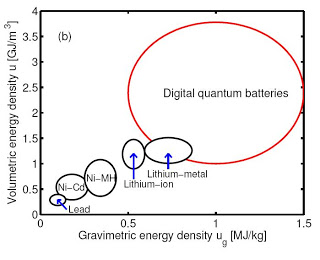This is a follow up on digital quantum batteries
Dr Alfred Hubler discusses the managing the risks of the high energy densities if digital quantum batteries are developed.
This is an exciting prospect. The introduction of digital batteries could spark an exciting transition from the nuclear age to a quantum engineering age.
The theoretical limit for electrostatic energy storage in quantum devices is very high. The energy density in heavy atoms, i.e. the ratio between the stored energy and atomic volume for an excitation from the ground state of heavy metal ions is 10,000 times higher than in hydrogen atoms. Based on this theoretical limit, the maximum density of retrievable energy in nano capacitors is comparable with the density of retrievable energy from nuclear reactions.
The rapid energy release of nano capacitors discharged by an electrical short makes them potent explosives, potentially exceeding the power of any chemical explosive. In contrast to nuclear explosives, the production of nano capacitors requires not radioactive substances but common, nonpoisonous, environmentally friendly chemicals. Without electrical charge, nano capacitors have no explosive power. In contrast to both nuclear and chemical explosives, simply using nano capacitors as batteries and slowly removing their charge as electrical current could easily and safely discharge them. In the discharged state, they could be shipped without safety concerns. At their destination they could be easily charged with electrical current. Even if an explosion were to occur, it would produce no radioactive waste, no long term radiation, and probably could be designed to produce no chemicals.
Technology to produce nano capacitors may already exist because similar quantum effects are used to keep charge separated in MTJ capacitors (used in MRAM), in flash drives and in laser diodes. In laser diodes, the recombination of electrons and holes is a forbidden transition. Therefore, the holes are long lived even if they are very close to the electrons. This leads to large electric fields. Literature data suggest that in standard laser diodes the electric field is above the breakthrough field of regular capacitors, and could be much larger. Conceivably, conventional flash drives could be used for energy storage, but they are not designed for this purpose: the substrates are thick and the energy to weight ratio is small. One could design large arrays of individually connected nano capacitors, to be charged and discharged one-by-one, similar to flash drives. In contrast to regular batteries, the output voltage would remain constant until the last nano capacitor is discharged. One could call these arrays of nano capacitors digital batteries. A digital battery’s stable output voltage is of key importance for sensors and other sensitive devices. However, the high energy density of such devices may pose a challenge in terms of safety. Charged digital batteries could explode if all nano capacitors were shorted simultaneously. In the electrically discharged state digital batteries probably pose no safety hazard whatsoever.
Vikas Shah, a Student of Hubler adds:
Despite the capacitors being better for the environment it should be taken into consideration that they are somewhat dangerous. While they hold no charge or if they are used responsibly and discharged slowly they are harmless. On the other hand if, say, one were to be fractured because of the design limitations stated above or because of improper use there would be consequences of catastrophic proportions. If a capacitor were to be broken the rapid release of electrons, depending on the charge being held within the plates, could cause an explosion like that of an atomic bomb.
One problem that Hubler faced was that in larger capacitors, namely parallel plate capacitors, is that when many electrons are stored on the negative plate they tent to repel each other and thusly push each other off of the plate and go to the positive plate. To work around this, Hubler looked to the atomic level where quantum phenomena prevent such happenings. For example we know that in an atom the nucleus and electrons are separate despite their charges. They coexist without attracting each other. Similarly, if very small capacitors, known as nano capacitors were made this problem of electrons pushing each other off plates would not occur. So, why not just make nano capacitors? Technology to create these nano capacitors already exists today. For example they can be seen in the MRAM component of flash drives. The problem as to why such capacitors aren’t already implemented into society today is because of limitations in design such as “tunneling and large tensions which may fracture the material” of the capacitors (Hubler). Also, capacitors right now do not hold much charge. Theoretically, capacitors can hold a much larger charge than batteries can. Because of this the maximum charge held by a capacitor is increasing at a faster rate than that of a battery. This is allowing capacitors to become more suited for commercial use. Although this is true, it will be a few years before capacitors can actually hold as much or more charge than a battery. When they do replace batteries not only will they be superior in holding a charge, they will be better for the environment.

Brian Wang is a Futurist Thought Leader and a popular Science blogger with 1 million readers per month. His blog Nextbigfuture.com is ranked #1 Science News Blog. It covers many disruptive technology and trends including Space, Robotics, Artificial Intelligence, Medicine, Anti-aging Biotechnology, and Nanotechnology.
Known for identifying cutting edge technologies, he is currently a Co-Founder of a startup and fundraiser for high potential early-stage companies. He is the Head of Research for Allocations for deep technology investments and an Angel Investor at Space Angels.
A frequent speaker at corporations, he has been a TEDx speaker, a Singularity University speaker and guest at numerous interviews for radio and podcasts. He is open to public speaking and advising engagements.


